Can we take the wheel of the DeLorean Speed Machine on display at Universal Studios and at 88 miles per hour create a time vortex ? We are in the middle of “Back to the Future” as projected on to a small, historic and picturesque town along a beach lined with by sand dunes… Welcome to Saint Augustine, “The Nation’s Oldest City,” on the East coast of Florida. Saint Augustine is known for its colonial architecture and also for some of oldest buildings in America, the oldest school (1763), the oldest prison (1891), the oldest shop (1840), the oldest House (1720)… To be more specific, it is the oldest continuous European settlement in the continental United States. Saint Augustine, founded in 1565, preceded both Jamestown (1607) and Port-Royal (1604). Another city of Florida, Pensacola at the western end of the panhandle was discovered in 1516 by the Spaniards and founded by Don Tristán de Luna y Arellano in 1559 and claims the title of the first European colony of the New World… But in the end, who care about a title ? Let’s discover Saint Augustine a small town-museum and one of the major “attractions” of Florida along with Orlando and its theme parks and Cape Canaveral.

Florida, une terre fleuries et flamboyante
In 1513, on Pascua Florida (Palm Day), Spanish explorer Juan Ponce de León arrived at the estuary of the St. Johns River to find a flowery and flamboyant land which he called Florida, (Land of Flowers). In 1562, King Philip II of Spain asked Pedro Menéndez de Avilés to lead a fleet to drive the French Huguenots from the area. After having massacred the French colonists Pedro Menéndez de Avilés and his handful of adventurers quietly pursued their route along the coast and took possession of the natural port of Saint Augustine on August 28th 1565, the day of St. Augustine and hence the name of the city… If Avilés had arrived two days earlier the city would have been called “Scooby doo” or “Snoopy“, August 26th be the National Dog Day. Don’t be silly, but wouldn’t it have been fun ? In the course of its history, Saint Augustine has passed several times from the Spanish Crown to Great Britain (under the command of the navigator Francis Drake in 1586 and later with the Treaty of Paris in 1763 ending the seven-year war and confirming British dominance in the New World.) Later the Treaty of Paris in 1783 ceded Florida back to the Spanish crown. After this long period of handball (a nasty game), under the Adams-Onis Treaty, also known as the Transcontinental Treaty of 1819, Spain ceded Florida, including the city of Santa Augustine, to the United States,. As a result of the Treaty, Florida then officially became part of the young nation in 1821.
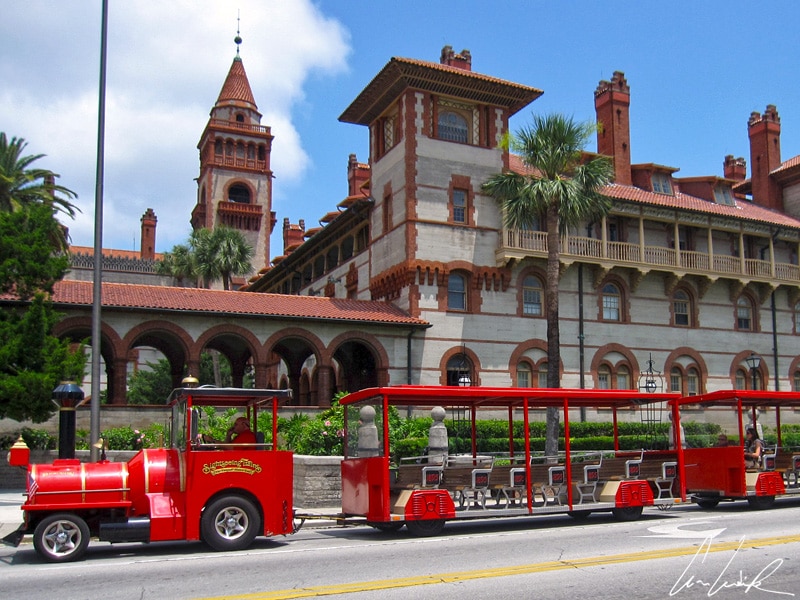
Saint Augustine, take the small train…
St. Augustine is a major tourist attraction. Flocks of tourists stroll along its cobblestone streets, relax in its cafes, and visit its charming shops (which sell junk made in distant lands) or explore the city’s history in its countless museums… The Spanish Military Hospital Museum covers medical practices of the colonial era. The guided tour includes several clinic demonstrations of amputation, the use of leeches and other practices of the time. Not for faint hearted! The charm of St. Augustine, its history and its superb setting make it a perfect place for history lovers. With its Spanish houses featuring overhanging balconies, its many monuments and picturesque streets, Saint Augustine has a true European feeling. If you prefer a less strenuous way of exploring the city, you can take horse-drawn carriage or small train. The historic district, classified a National Historic Landmark District is very touristy. St. George Street is the main street of the old quarter. The Dow Museum of Historic Houses, which includes nine historic houses built between 1790 and 1910, is situated in a quadrilateral bordered by St. George, Bridge, Cordova and St Joseph Convent streets. The city proudly maintains its Spanish Quarter, a reproduction of a Spanish colonial quarter of the 18th century. In a set of beautifully restored wooden houses and workshops, persons dressed in colonial costume bake bread and work iron, leather or wood in restored workshops, or sit at a loom. In this reconstruction, there is a hint of nostalgia. The Oldest Wood School House is at 14 Saint George Street and is made of bald cedar and red cypress. Inside, a reconstruction attempts to recreate the atmosphere of the time school books, slates, pens and old maps.
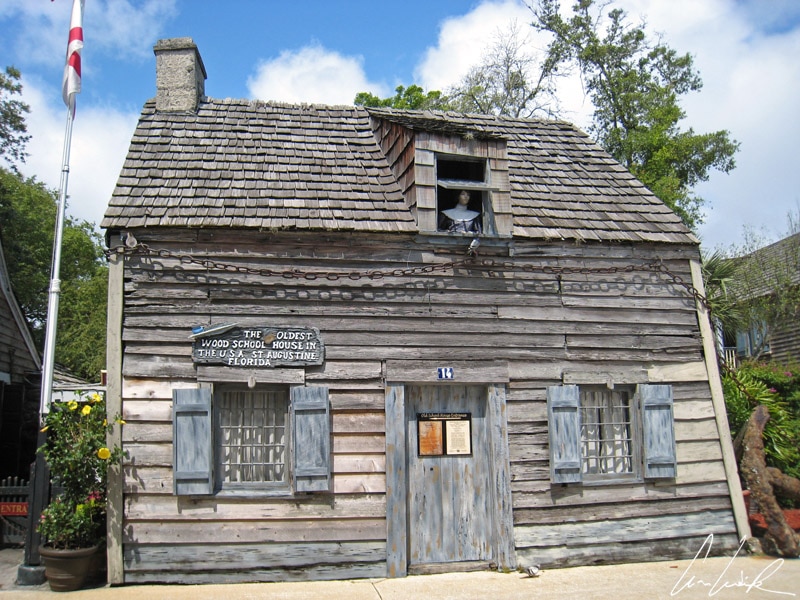
The Oldest Wood School House
Strolling across the streets of Saint Augustine, you can admire Moorish Revival buildings including Flagler College, formerly the Ponce de Leon Hotel and built by Henry M. Flagler in 1888. On our path we can also admire the Alcazar Hotel City Hall and the Casa Monica Hotel, both in the same style. The name of Henry M. Flagler is omnipresent in Florida. About 1885, Flagler foresaw the potential of St. Augustine and bought several railroads, combing them to form the Florida East Coast Railway. The idea was to make Saint Augustine a winter resort for wealthy Americans from New York, a train journey of less than one day. The northerners were attracted by the exceptional natural setting and climate. In Saint Augustine they stayed in one of the two luxury hotels, the Ponce de León Hotel (1888) and the Alcazar Hotel (1889) both of which belonged to Henry M. Flagler… The golden age of Saint Augustine followed and lasted until the Great Depression of 1929 and the advent of Palm Beach … It is difficult to describe the beauty of the Flagler College campus with its brick Moorish-style buildings and red-tiled roofs. It is decorated with large turrets, and the green spaces, composed of palm trees, are magnificent. The Molly Wiley Art Building, built between1885 and 1887, is recognizable by its large chimney serving four electric dynamos that supplied electricity to the Ponce de Leon Hotel and artists’ studios. Since renovation in 2007, the building is used for offices, student classrooms for the fine arts and graphic design departments.

Memorial Presbytarian Church
Other buildings deserved a look for their fine architecture… Cathedral Basilica of Saint Augustine built between 1793 and 1797. The original building was constructed in 1565 and re-built several times after fires. When the Spanish regained the control of Florida after 1783, the current imposing cathedral was planned and built in a Spanish Renaissance colonial style. The bell tower and the transverse nave were added after the fire of 1887. The edifice holds the oldest written texts in the United States, parish documents dating from 1594. Finally, the visit would be incomplete without admiring the beautiful Flagler Memorial Presbyterian Church (1889), dedicated in honor of Henry M. Flagler’s daughter Jenny Louise. The construction took less than a year, which is an accomplishment. Nearby the Trinity Episcopal Church (1830-1831) is… you guessed it… the oldest Protestant church in Florida. In a different style, the Castillo San Marcos is an impressive fortress (Spanish, then British and finally American) with four bastions located at its four corners. It is, of course, the oldest masonry fort in the United States (just as we suspected). The Spanish built the fort from 1672 to 1695 to protect themselves from English, Amerindian enemies and pirates. The fort is surrounded a moat connected to Matanzas Bay, and during high tide it was flooded with sea water. The fort resisted invasion thanks to its star shape structure, its large walls between 20 and 30 feet thick and made of “coquina”, (Spanish for small shells), and also the use of floodgates built into the seawall. The “coquina” is a type of limestone sedimentary rock formed of shells bound together and found on the coasts of Florida. “Coquina” has the property of not splitting and of absorbing shocks… hence cannon bullets, instead of breaking the walls, get stuck in the wall.
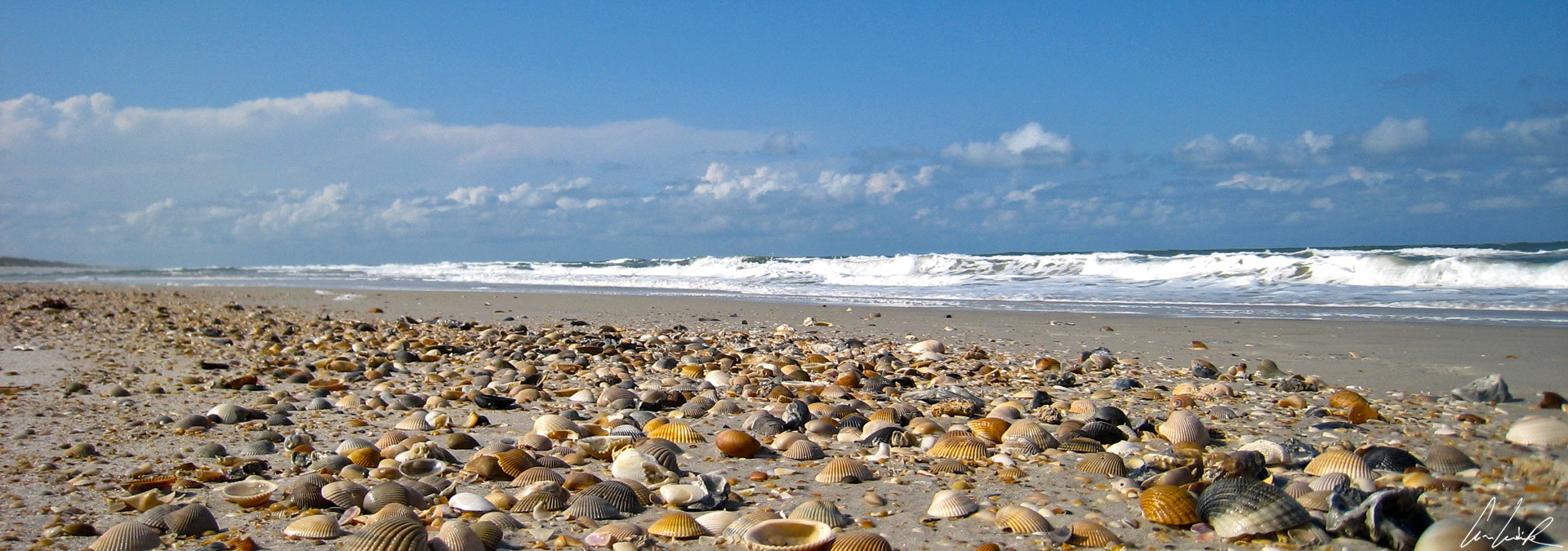
Anastasia Island State Park, collect seashells on the sandy beach
If you still have some energy left, you can end your visit by courageously climbing the 219 steps of the St. Augustine Lighthouse. From its 165 feet height, you have a breathtaking panoramic view. The white and black tower painted in spiral design like a sugar cane and surmounted by a red lantern was built in 1874 on the north end of Anastasia Island. The island faces Saint Augustine and is accessible by the Bridge of Lions. At the foot of the lighthouse, the caretaker’s house was restored after a devastating fire in 1970 and transformed into a museum recounting local maritime history… because, of course, Saint Augustine is also the oldest port in the United States as well… Bouh! The lighthouse and its surroundings are favorite places among “ghost hunters”. Some visitors have seen a shadow with the long evanescent hair passing through, and tourist guides say they have heard someone climbing the steps but no one is ever at the top of the tower. The Atlantic Paranormal Society (TAPS) brought in audio and video equipment to try whether to prove or not that the lighthouse is haunted… It was featured on the Syfy TV series Ghost Hunters in which a woman’s voice seems to say repeatedly “help me” on the audio recording and the video camera captured a dark silhouette moving very quickly down the circular staircase and then stopping to look down on the camera team from the top floor… Reality or trickery ! In any case, a ship’s captain could say to passing sailors, “flee this lighthouse”! But it is time to take a long break from “History”, and relax our neurons (which are getting old too!) on the beautiful sandy beaches of Anastasia State Park. The Anastasia State Park offers 4 miles of untouched beaches and covers a total area of 1,600 acres of a rich ecosystem of great natural beauty and wildlife. Discover and take a self-guided tour along the nature trail; observe the seabirds that live on the salt marsh, and explore the maritime hammock on ancient sand dunes, the oldest dunes in the United States… no, Joke!, Collect seashells on the sandy beaches or just lie down with a good book and listen to breaking waves in the background… Close your eyes and relax… you feel great warmth and a fatigue, a torpor that takes possession of your entire body (ah, remember Ghostbusters !). The lassitude becomes stronger and stronger. You feel that you cannot resist. You inhale, exhale in harmony with the sound of the waves: inhale, and exhale slowly. You are totally relaxed, calm, and enjoying every moment until sunset.


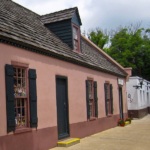

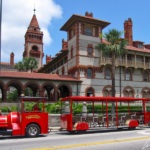
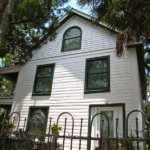

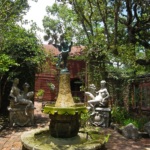




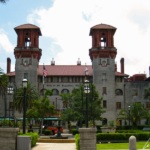


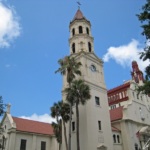
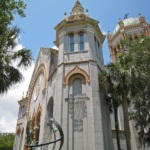
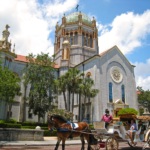
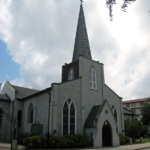


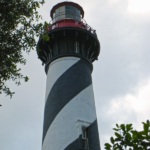
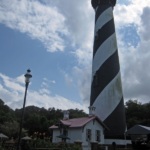
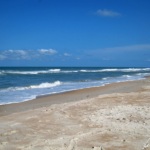

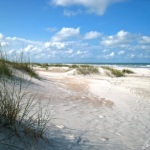
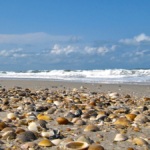



Such a beautifully written post! Can you believe I have lived in Florida almost all my life and never visited the oldest city in the US? I really need to take the trip to visit! Your post really makes me realize that! Thanks for sharing!
Thank you 🙂 It’s a great city to just walk around and explore because there are so many hidden shops and restaurants tucked away on side streets, not to mention some great Spanish architecture to feast your eyes on 🙂
So much history in this tiny place! Loved reading about the different landmarks
The best way to see and learn the history is to simply hop on one of the trolley rides (Red Train Tours or Old Town Trolley Tours). You’ll discover everything from the oldest wooden schoolhouse, to the oldest house, to the Authentic Old Jail, as well as amazing stories about Henry Flagler and Martin Luther King Jr.
St. Augustine looks amazing! I’ve lived in Florida for almost a whole year now and haven’t made it up there. There seems to be so much to do and see. This has inspired me to add it to my fall travels this year 🙂
The history is my favorite part of this city. Take time to stroll down the cobbled stoned streets and tour the beautiful camps of Flagler University. It’s a lot of walking, but the best way to see and learn the history is to simply hop on one of the trolley rides.
This looks really interesting! Good to see a working horse in pretty good shape… sorry, being a horsey person, that’s the first thing I see whenever there’s a travel blog with a horse in it! I think I’d be freaked out by the spooky lighthouse even though I definitely don’t believe in ghosts haha.
Sightseeing in St. Augustine is fun and easy if you know where to look. The clip clop of horse hooves, red brick streets, and tree covered streets will relax you so you can absorb the history of St. Augustine A narrated tour in a horse drawn carriage can be a memorable family event ! If you are OK with ghosts, consider a spin on the Ghosts & Graveyards trolley tour. On this tour, you’ll visit Potter’s Wax Museum to hear the legendary execution about a famous pirate, as well as an up close and personal tour of the “Old Jail”… Read more »
I’ve always wanted to visit St. Augustine! Oldest area in the US, right? What history!
As the oldest city in the US, St. Augustine has been the quintessential melting pot for many cultures (Spanish, French, British, to name a few) for over 450 years. It is a fantastic place for the history lovers !
I visited St Augustine on my first trip to the US many years ago before I moved here it was SUCH a cute little town!
From the architecture to the food to the arts, you’ll experience in St Augustine the kind of culture, diversity and history you’d expect from an old world European city 🙂
Great pics! I visited St Augustine as a teenager and still remember what a beautiful city it was.
An the “old” buildings are probably still looking the same as you remember !
Great tips to visit St Augustine ! I haven’t been to Florida in years because I am from South America and that’s a long distance from us, but hey when I come back I will sure follow this tips !
Thank you 🙂 Indeed, for you it’s a long trip to go there ! St. Augustine is known for being the oldest city in the US, but with that title comes the inevitable tacky tourist trap attractions but there are some sites that are really worth seeing.
What a fantastic place for the history lovers! This lovely place is probably not everyone`s cup of tea but it must be so fascinating to stroll through the streets as there seem to be so many wonderful stories to be told about St Augustine.
From the museums in St. Augustine’s historic downtown district to the beach activities on Anastasia Island, this city has it all ! Every corner is rich with a long history, waiting to be discovered.
What! This looks SO cool. I have to admit I’d never heard of Saint Augustine before, but it’s probably because I’m such a pop culture geek that Universal Studios/Disneyworld always way eclipsed any other attractions in Florida. Pretty incredible that it boasts “the oldest” of so many things, and some of the architecture is stunning as well. Definitely making note of this when I eventually make it to Florida! 🙂
St Augustine is only a few hours away from Orlando to the South. You will find a wide range of attractions and activities in the nation’s oldest city 🙂
I love learning about historical places when I travel. I’m a huge history buff so I’ve always wanted to visit St. Augustine. One of my biggest regrets of my time living in Orlando is that I never made a day trip out there. I’ll just have to go back on a vacation now.
I’m sure you will enjoy exploring the cobblestone streets and find historic sites all around downtown. Every corner is rich with a long history, waiting to be discovered 🙂
So much fun learning about St. Augustine in Florida! I didn’t know there was so much history. And Anastasia Island looks beautiful!
The history is my favorite part of this city 🙂 From the museums in St. Augustine’s historic downtown district to the beach activities on Anastasia Island, this city has it all !
Wow fascinating history of the city! I might move to FL in the next year or two so I should definitely check out this town if I do!
It’s a great city to just walk around and discover everything from the oldest wooden schoolhouse, to the oldest house, to the Authentic Old Jail, as well as amazing stories about Henry Flagler and Martin Luther King Jr.
i’m in florida too! I haven’t been to st. augustine in years but i’ve got to go back!
It’s a great city to just walk around and discover St. Augustine’s historic downtown district, museums and of course the beach activities on Anastasia Island 🙂